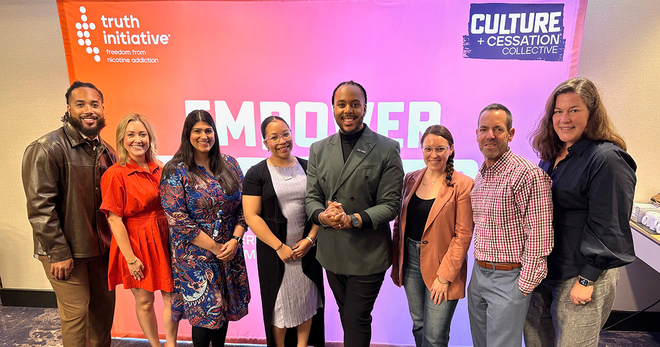truth campaign proven to drive down smoking rates across different demographic groups
New research shows that the truth® tobacco prevention campaign has been broadly effective among important demographic groups – including young Black Americans, those with lower incomes, and those who live in rural areas – that have been historically targeted by the tobacco industry and are at higher risk of tobacco use.
The new Truth Initiative study, published in the journal Health Education Research, found that the truth campaign has been effective and relevant for a broad audience of young people. Higher levels of campaign exposure were associated with lower rates of intentions to smoke and current use of cigarettes across racial/ethnic subgroups, as well as among lower-income and rural populations, compared to low levels of campaign exposure.
While previous research has shown that truth has been effective at preventing tobacco use at a population level, this is the first study to show whether the campaign equally influences different demographic groups. Many groups, including Black Americans and those from low-income and rural communities, have been disproportionately impacted by tobacco use. For example, the tobacco industry strategically and aggressively targeted the community with menthol cigarettes for decades, including placing more advertising in predominantly black neighborhoods and in publications that are popular with black audiences, as well as appropriating culture in marketing, including sponsoring events such as jazz and hip-hop festivals.
truth campaign equitably reaches vulnerable groups
Truth Initiative researchers measured weekly exposure to campaign ads and surveyed 15-24-year-olds about their cigarette use and intentions to smoke. Overall, in weeks with greater campaign exposure levels, there was an 8% decrease in the odds of intentions to smoke cigarettes and an 11% decrease in current cigarette use, compared to weeks where campaign exposure was lower.
Researchers saw similar trends across racial/ethnic subgroups (including non-Hispanic Black and Hispanic young people), those of lower income, and those living in rural areas: higher ad exposure levels were associated with lower rates of intentions to smoke and current smoking rates.
Relevant messaging designed to appeal to diverse audiences
The study authors write that the campaign was successful across broad audiences because it coupled tobacco facts with issues that young people already care about. Campaign messages integrated the deceptive practices of the tobacco industry with popular among the target audience. For example, messages highlighted the increased targeted marketing of cigarettes in Black neighborhoods and the increase in tobacco retailers in low-income neighborhoods. The messaging was also designed to appeal to this generation’s interest in collective action by calling on them to end tobacco as a generation.
Findings from this study support the idea that a single comprehensive anti-tobacco mass media campaign aimed at a target population with sufficient message exposure can effectively reduce tobacco use.
The authors write: “Mass media tobacco prevention campaigns can be an effective and critical component of a comprehensive tobacco control program, particularly among communities who suffer disproportionately from tobacco disease and death.”
More in tobacco prevention efforts
Want support quitting? Join EX Program
By clicking JOIN, you agree to the Terms, Text Message Terms and Privacy Policy.
Msg&Data rates may apply; msgs are automated.


